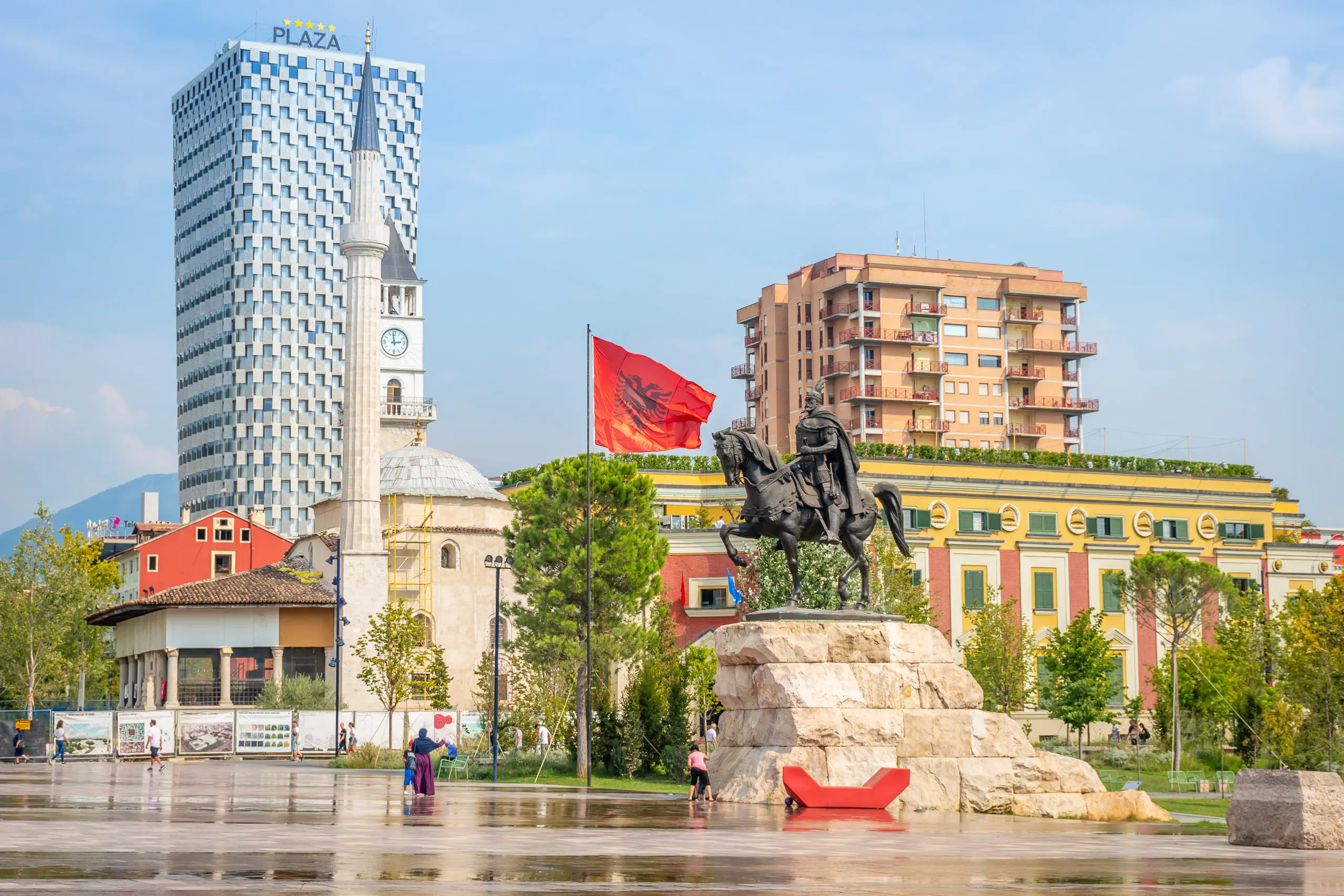
Key Takeaways
- Skanderbeg Square is the central hub of Tirana, symbolizing Albania’s history and culture.
- The square’s origins trace back to the Ottoman era, with transformative phases under Italian occupation and communism.
- Dedicated to Albania’s national hero, Gjergj Kastrioti Skanderbeg, the square embodies resistance and independence.
- The square houses landmarks like the Skanderbeg Statue, National History Museum, Et’hem Bey Mosque, and more.
- Recent renovations have revitalized the space, emphasizing pedestrian areas and green zones for social gatherings.
Table of contents
- Introduction: Skanderbeg Square
- Historical Background: The Rich Past of Skanderbeg Square
- Location and Layout: The Geographical and Architectural Marvel of Tirana
- Key Attractions and Monuments: Embodiments of Culture and History
- Social and Cultural Importance: The Heartbeat of Public Life
- Visitor Information: Enhance Your Skanderbeg Square Experience
- Conclusion: Why Skanderbeg Square is a Must-See Landmark
Welcome to the vibrant heart of Tirana — Skanderbeg Square. This iconic plaza is more than just a physical space; it’s a living monument to Albania’s resilience, history, and cultural soul. As *Sheshi Skënderbej*, it has seen epochs of change, from Ottoman roots to socialist grandeur, and now, a modern urban renaissance.
Introduction: Skanderbeg Square
Situated centrally within Tirana, Skanderbeg Square is where history, culture, and urban life converge. It’s a place where locals and visitors alike gather to commemorate, celebrate, and simply enjoy the lively ambiance. Whether you’re exploring its monuments, attending festivals, or relaxing in green spaces, this square pulses with the spirit of Albania.
Historical Background: The Rich Past of Skanderbeg Square
The History and Origin of Skanderbeg Square
Skanderbeg Square’s story stretches back to Ottoman times, initially as a modest open space. Over centuries, it evolved through various regimes: the Italians introduced neo-classical influences, while the communists transformed it into a grand socialist plaza, often hosting mass rallies and parades. Post-1990s, efforts focused on pedestrianization and urban renewal, turning it into the vibrant public space we see today.
Who Was Skanderbeg?
Gjergj Kastrioti Skanderbeg (1405–1468) is Albania’s national hero, celebrated for fiercely resisting Ottoman domination for over two decades. His leadership symbolizes Albanian independence and resilience. The statue at the square depicts him as a heroic figure, embodying the spirit of freedom.
Notable Historical Events and Transformations
The square has been a stage for pivotal moments: from communist mass rallies to democratic protests post-1990s. It reflects Albania’s political and social shifts, constantly transforming to serve the needs of its people.
Location and Layout: The Geographical and Architectural Marvel of Tirana
Geographic Location of Skanderbeg Square in Tirana
Nestled in the very heart of Tirana, the square connects major streets like Dëshmorët e Kombit and Skanderbeg Boulevard. Its central position makes it accessible and prominent within the city’s urban fabric.
Architectural Design and Notable Features of the Square
Designed with a mix of traditional Albanian materials and modern elements, the square’s mosaic stone paving reflects regional diversity. The recent renovation introduced expansive pedestrian zones, lush green landscaping, and modern lighting, creating an inviting atmosphere.
Recent Renovations and Urban Development
Completed in 2017, the renovation aimed to reduce vehicle traffic, expand green spaces, and boost pedestrian access, making the square more inclusive and lively. The project emphasizes social interaction and cultural expression.
Key Attractions and Monuments: Embodiments of Culture and History
Landmarks within and around Skanderbeg Square
The square is home to several iconic sites: the bronze Skanderbeg Statue at the center, the National Historical Museum showcasing Albania’s past, the Et’hem Bey Mosque with its detailed frescoes, the Clock Tower, and the National Opera and Ballet Theatre. These landmarks are accessible and essential to understanding Albania’s cultural landscape. For more details, see the [Official Tirana Tourism Guide](https://albaniaturism.com/st_tour/skanderbeg-square-tirana).
Cultural and Historical Importance of Landmarks
Each monument embodies a piece of Albanian identity: Skanderbeg’s statue symbolizes national pride, the museum narrates historical struggles, and religious sites like Et’hem Bey Mosque reveal religious diversity. These structures collectively illustrate the nation’s multifaceted culture. To explore deeper insights, refer to museum catalogs and academic articles on Albanian heritage.
Social and Cultural Importance: The Heartbeat of Public Life
Skanderbeg Square as a Gathering Place
The square is a lively nexus for locals and tourists, hosting celebrations, markets, and social events. It’s where community bonds are strengthened and national pride is expressed. Personal stories and sociological studies, such as those on public spaces in Tirana, emphasize its vital role.
Events and Festivals at Skanderbeg Square
Throughout the year, the square comes alive with ceremonies like Independence Day, cultural festivals, concerts, and seasonal markets. These events foster a sense of community and showcase Albanian culture.
The Square’s Role in Albanian Public Life and Identity
As a symbol of unity and national identity, Skanderbeg Square functions as a space for historical memory and cultural expression. It bridges past and future, serving as a backdrop for important national dialogues and celebrations. For in-depth analysis, see academic articles on Albanian national identity.
Visitor Information: Enhance Your Skanderbeg Square Experience
Visiting Tips for Skanderbeg Square
The best time to visit is spring or fall when the weather is mild. The square is accessible all year, with public buses and taxis nearby. Wear comfortable shoes for walking and exploring the area fully.
Nearby Amenities and Transport Links
Within walking distance, you’ll find cafes, restaurants, shops, and cultural venues. The square connects seamlessly to hotels and transit routes. Use Google Maps for detailed maps and transport options.
Suggestions for Tours and Activities
Join guided walking tours of Tirana that include Skanderbeg Square or explore independently. Nearby museums and historic neighborhoods offer immersive experiences. Check with local tour operators or travel forums for customized itineraries.
Conclusion: Why Skanderbeg Square is a Must-See Landmark
Skanderbeg Square encapsulates the spirit of Albania — its history, resilience, and vibrant culture. As the nucleus of Tirana’s social and political life, it invites visitors to reflect on the nation’s journey and envision its future. Whether admiring monuments, participating in festivities, or simply soaking in the energetic atmosphere, this square remains a quintessential destination. Experience the enduring legacy and lively pulse of Albania at Skanderbeg Square, an unmissable landmark.”


0 Comment